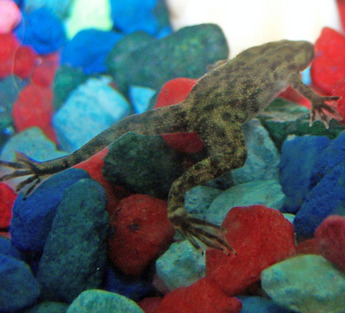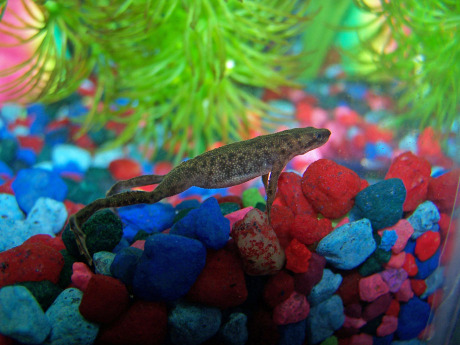The African Dwarf Frog is also called by its latin name "Hymenochirus Curtipes". Originally, the African Dwarf Frogs were abundant in the streams and small rivers of Central Africa. The African Dwarf frog is fully aquatic, meaning that it does not need to leave the water at all. The adult African dwarf frog may grow up to 2.5" in length. The colors of the African Dwarf frog ranges from a pale olive green to a brownish green. Because of their size, they can easily be kept in a large community tank with other aquarium fish.
With proper care, the African dwarf frogs may even live up to 5 years. Its favorite diet consists of brine shrimps and bloodworms. African dwarf frog is not a very picky eater and will eat fresh or frozen food. It also eats sinking fish food pellets. These semi-scavengers should be fed every alternate day. But, then again, since they are scavengers, they will eat almost anything that is provided to them.
The African dwarf frogs need to be kept in a large tank of 10-gallon or more. Since they are basically frogs that are prone to jumping, the tank MUST have a covered top. The ideal water temperature for the African dwarf frog is 72 degree F to 82 degree F.
As with any other aquatic specie, the African dwarf frog needs a stable water temperature, water quality and pH levels. The African dwarf frog is a rather timid and shy amphibian. It will always try to swim away from any attempts to catch it. Hence, it is also essential to provide these amphibian lots of hiding places. A rather curious habit of the African dwarf frog is that it is generally seen sitting in front of the current that is created by the filter. If the African dwarf frog is kept in an aquarium, it is necessary to check filter, water quality and temperature on a daily basis. Any new fish should be introduced gradually into such a tank, since the African dwarf frog is itself rather fragile and timid.

African Dwarg frog.
The African dwarf frog generally does well if it is kept with other like-minded and docile fish, like the loaches and community tetras. They also mix well with others of their own species, irrespective of their sex. A happy and healthy African dwarf frog can be spotted from its various activities and general disposition. It will be very active and vigorous. The healthy African dwarf frog swims very vigorously, and eats very voraciously. It is mostly in hiding and sticks to the bottom regions of the tank. It will have clear eyes and a smooth skin.
Most African Dwarf Frogs are very sturdy in that they do not fall sick too easily. Overcrowding is the biggest known cause of stress and disease among the African dwarf frogs. That is why it is essential to give these amphibians as much legroom as possible. Adequate space, good water quality and an efficient filter system will ensure the health of the African dwarf frog.
The African dwarf frog is most susceptible to bacterial infection. The symptoms may include cloudy eyes. Any open sores or reddening of the skin may also indicate infection. Use of appropriate anti-bacterial medicine and a water change are usually enough to take care of this problem. Another common infection in the African dwarf frog is caused by fungus. Inflammation of the skin that makes it look red and sore, or any other abnormal coloring of the skin is something to watch out for. Such a frog should be quarantined immediately. Malachite green-based medication is usually effective in this situation.

African Dwarg frog searching for food.
Didn't find the info you were looking for? Register for free and ask your question in our Aquarium forum !
Our knowledgeable staff usually responds to any question within 24 hours
Related Articles:
Claw Frog - A basic article about Claw Frogs
Red-eared sliders - A basic article about Red-eared slider turtles
Turtle aquarium - A guide on how to setup a suitable turtle aquarium



